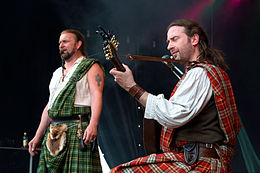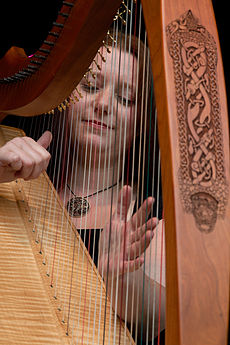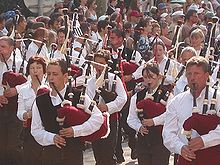Celtic music

Celtic music is a broad grouping of music genres that evolved out of the folk music traditions of the Celtic people of Western Europe.[1][2] It refers to both orally-transmitted traditional music and recorded music and the styles vary considerably to include everything from "trad" (traditional) music to a wide range of hybrids.
Description and definition

Celtic music means two things mainly. First, it is the music of the people that identify themselves as Celts. Secondly, it refers to whatever qualities may be unique to the music of the Celtic Nations. Many notable Celtic musicians such as Alan Stivell and Paddy Moloney[3] claim that the different Celtic music genres have a lot in common.[1][2][4]
These following melodic practices may be used[4] widely across the different variants of Celtic Music:

- It is common for the melodic line to move up and down the primary chords in many Celtic songs. There are a number of possible reasons for this:
- Melodic variation can be easily introduced. Melodic variation is widely used in Celtic music, especially by the pipes and harp.
- It is easier to anticipate the direction that the melody will take, so that harmony either composed or improvised can be introduced: cliched cadences that are essential for impromptu harmony are also more easily formed.
- The relatively wider tonal intervals in some songs make it possible for stress accents within the poetic line to be more in keeping with the local Celtic accent.
- Across just one Celtic group.
- By more than one Celtic language population belonging to different Celtic groups.
These two latter usage patterns may simply be remnants of formerly widespread melodic practices.
Often, the term Celtic music is applied to the music of Ireland and Scotland because both lands have produced well-known distinctive styles which actually have genuine commonality and clear mutual influences. The definition is further complicated by the fact that Irish independence has allowed Ireland to promote 'Celtic' music as a specifically Irish product. However, these are modern geographical references to a people who share a common Celtic ancestry and consequently, a common musical heritage.
These styles are known because of the importance of Irish and Scottish people in the English speaking world, especially in the United States, where they had a profound impact on American music, particularly bluegrass and country music.[5] The music of Wales, Cornwall, the Isle of Man, Brittany, Galicia, Cantabria and Asturias (Spain) and Portugal are also considered Celtic music, the tradition being particularly strong in Brittany,[6] where Celtic festivals large and small take place throughout the year,[7] and in Wales, where the ancient eisteddfod tradition has been revived and flourishes. Additionally, the musics of ethnically Celtic peoples abroad are vibrant, especially in Canada and the United States. In Canada the provinces of Atlantic Canada are known for being a home of Celtic music, most notably on the islands of Newfoundland, Cape Breton and Prince Edward Island. The traditional music of Atlantic Canada is heavily influenced by the Irish, Scottish and Acadian ethnic makeup of much of the region's communities.[8] In some parts of Atlantic Canada, such as Newfoundland, Celtic music is as or more popular than in the old country. Further, some older forms of Celtic music that are rare in Scotland and Ireland today, such as the practice of accompanying a fiddle with a piano, or the Gaelic spinning songs of Cape Breton remain common in the Maritimes. Much of the music of this region is Celtic in nature, but originates in the local area and celebrates the sea, seafaring, fishing and other primary industries.
Divisions

In Celtic Music: A Complete Guide, June Skinner Sawyers acknowledges six Celtic nationalities divided into two groups according to their linguistic heritage.[9] The Q-Celtic nationalities are the Irish, Scottish and Manx peoples, while the P-Celtic groups are the Cornish, Bretons and Welsh peoples. Musician Alan Stivell uses a similar dichotomy, between the Gaelic (Irish/Scottish/Manx) and the Brythonic (Breton/Welsh/Cornish) branches, which differentiate "mostly by the extended range (sometimes more than two octaves) of Irish and Scottish melodies and the closed range of Breton and Welsh melodies (often reduced to a half-octave), and by the frequent use of the pure pentatonic scale in Gaelic music."[10]
There is also tremendous variation between Celtic regions. Ireland, Scotland, Brittany and Wales have living traditions of language and music, and there has been a recent major revival of interest in Celtic heritage in Cornwall and the Isle of Man. Galicia has a Celtic language revival movement to revive the Q-Celtic Gallaic language used into Roman times.[11][12][13][14] Most of the Iberian Peninsula had a similar Celtic language in pre-Roman times. A Brythonic language was used in parts of Galicia and Asturias into early Medieval times brought by Britons fleeing the Anglo-Saxon invasions via Brittany.[15][16] The Romance language currently spoken in Galicia, Galician (Galego) is closely related to the Portuguese language used mainly in Brazil and Portugal. Galician music is claimed to be Celtic.[2] The same is true of the music of Asturias,[2] Cantabria, and that of Northern Portugal (some say even traditional music from Central Portugal can be labeled Celtic).
Breton artist Alan Stivell was one of the earliest musicians to use the word Celtic and Keltia in his marketing materials, starting in the early 1960s as part of the worldwide folk music revival of that era[17][18] with the term quickly catching on with other artists worldwide. Today, the genre is well established and incredibly diverse.
Forms
There are musical genres and styles specific to each Celtic country, due in part to the influence of individual song traditions and the characteristics of specific languages:[19]
- Celtic traditional music
- Strathspeys are specific to Highland Scotland, for example, and it has been hypothesized that they mimic the rhythms of the Scottish Gaelic language.[20]
- Reels
- Pibroch
- Cerdd Dant (string music) or Canu Penillion (verse singing) is the art of vocal improvisation over a given melody in Welsh musical tradition. It is an important competition in eisteddfodau. The singer or (small) choir sings a counter melody over a harp melody.[21]
- Waulking song
- Puirt à beul
- Kan ha diskan
- Sean-nós song
- Celtic hip hop
- Celtic rock
- Celtic metal
- Celtic punk
- Celtic fusion
Festivals
- See list of Celtic festivals for a more complete list of Celtic festivals by country, including music festivals. Festivals focused largely or partly on Celtic music can be found at Category:Celtic music festivals.
The modern Celtic music scene involves a large number of music festivals, as it has traditionally. Some of the most prominent festivals focused solely on music include:
- Festival Internacional do Mundo Celta de Ortigueira (Ortigueira, Galicia, Spain)
- Festival Intercéltico de Avilés (Avilés, Asturies, Spain)
- Folixa na Primavera (Mieres, Asturies, Spain)
- Festival Celta Internacional Reino de León, (León, Spain)
- Festival Internacional de Música Celta de Collado Villalba (Collado Villalba, Spain)
- Yn Chruinnaght (Isle of Man)
- Celtic Connections (Glasgow, Scotland)[22]
- Hebridean Celtic Festival (Stornoway, Scotland)[23]

- Fleadh ceol na hÉireann (Tullamore, Ireland)
- Festival Intercéltico de Sendim (Sendim, Portugal)[24][25]
- Galaicofolia (Esposende, Portugal)[26]
- Festival Folk Celta Ponte da Barca (Ponte da Barca, Portugal)
- Douro Celtic Fest (Vila Nova de Gaia, Portugal)
- Festival Interceltique de Lorient (Lorient, France)[27]
- Festival del Kan ar Bobl (Lorient, France)
- Festival de Cornouaille (Quimper, France)
- Les Nuits Celtiques du Stade de France (Paris, France)
- Montelago Celtic Night (Colfiorito, Macerata, Italy)
- Triskell International Celtic Festival (Trieste, Italy)
- Festival celtique de Québec or Québec city celtic festival, (Quebec city, Quebec, Canada)[28]
- Festival Mémoire et Racines (Joliette, Quebec, Canada)
- Celtic Colours (Cape Breton, Nova Scotia)
- Paganfest (Tour through Europe)
Celtic fusion
The oldest musical tradition which fits under the label of Celtic fusion originated in the rural American south in the early colonial period and incorporated Scottish, Scots-Irish, Irish, Welsh, English, and African influences. Variously referred to as roots music, American folk music, or old-time music, this tradition has exerted a strong influence on all forms of American music, including country, blues, and rock and roll.[29] In addition to its lasting effects on other genres, it marked the first modern large-scale mixing of musical traditions from multiple ethnic and religious communities within the Celtic diaspora.
In the 1960s several bands put forward modern adaptations of Celtic music pulling influences from several of the Celtic nations at once to create a modern pan-celtic sound. A few of those include bagadoù (Breton pipe bands), Fairport Convention, Pentangle, Steeleye Span and Horslips.
In the 1970s Clannad made their mark initially in the folk and traditional scene, and then subsequently went on to bridge the gap between traditional Celtic and pop music in the 1980s and 1990s, incorporating elements from new-age, smooth jazz, and folk rock. Traces of Clannad's legacy can be heard in the music of many artists, including Enya, Donna Taggart, Altan, Capercaillie, The Corrs, Loreena McKennitt, Anúna, Riverdance and U2. The solo music of Clannad's lead singer, Moya Brennan (often referred to as the First Lady of Celtic Music) has further enhanced this influence.
Later, beginning in 1982 with The Pogues' invention of Celtic folk-punk and Stockton's Wing blend of Irish traditional and Pop, Rock and Reggae, there has been a movement to incorporate Celtic influences into other genres of music. Bands like Flogging Molly, Black 47, Dropkick Murphys, The Young Dubliners, The Tossers introduced a hybrid of Celtic rock, punk, reggae, hardcore and other elements in the 1990s that has become popular with Irish-American youth.
Today there are Celtic-influenced subgenres of virtually every type of popular music including electronica, rock, metal, punk, hip hop, reggae, new-age, Latin, Andean and pop. Collectively these modern interpretations of Celtic music are sometimes referred to as Celtic fusion.
Other modern adaptations
Outside of America, the first deliberate attempts to create a "Pan-Celtic music" were made by the Breton Taldir Jaffrennou, having translated songs from Ireland, Scotland, and Wales into Breton between the two world wars. One of his major works was to bring "Hen Wlad Fy Nhadau" (the Welsh national anthem) back in Brittany and create lyrics in Breton. Eventually this song became "Bro goz va zadoù" ("Old land of my fathers") and is the most widely accepted Breton anthem. In the 70s, the Breton Alan Cochevelou (future Alan Stivell) began playing a mixed repertoire from the main Celtic countries on the Celtic harp his father created.[18]
Probably the most successful all inclusive Celtic music composition in recent years is Shaun Daveys composition 'The Pilgrim'. This suite depicts the journey of St. Colum Cille through the Celtic nations of Ireland, Scotland, the Isle of Man, Wales, Cornwall, Brittany and Galicia. The suite which includes a Scottish pipe band, Irish and Welsh harpists, Galician gaitas, Irish uilleann pipes, the bombardes of Brittany, two vocal soloists and a narrator is set against a background of a classical orchestra and a large choir.
Modern music may also be termed "Celtic" because it is written and recorded in a Celtic language, regardless of musical style. Many of the Celtic languages have experienced resurgences in modern years, spurred on partly by the action of artists and musicians who have embraced them as hallmarks of identity and distinctness. In 1971, the Irish band Skara Brae recorded its only LP (simply called Skara Brae), all songs in Irish. In 1978 Runrig recorded an album in Scottish Gaelic. In 1992 Capercaillie recorded "A Prince Among Islands", the first Scottish Gaelic language record to reach the UK top 40. In 1996, a song in Breton represented France in the 41st Eurovision Song Contest, the first time in history that France had a song without a word in French. Since about 2005, Oi Polloi (from Scotland) have recorded in Scottish Gaelic. Mill a h-Uile Rud (a Scottish Gaelic punk band from Seattle) recorded in the language in 2004.
Several contemporary bands have Welsh language songs, such as Ceredwen, which fuses traditional instruments with trip hop beats, the Super Furry Animals, Fernhill, and so on (see the Music of Wales article for more Welsh and Welsh-language bands). The same phenomenon occurs in Brittany, where many singers record songs in Breton, traditional or modern (hip hop, rap, and so on.).
See also
- Folk music of Ireland
- Music of Brittany
- Music of Cornwall
- Music of Galicia, Cantabria and Asturias
- Music of the Isle of Man
- Music of Scotland
- Music of Wales
- Music of Portugal
- Traditional Gaelic music
References
- ^ a b Melhuish, Martin (1998). Celtic Tides: Traditional Music in a New Age. Ontario, Canada: Quarry Press Inc. pp. 8, 28. ISBN 1-55082-205-5.
- ^ a b c d Alberro, Manuel (2005). "Celtic Legacy in Galicia". E-Keltoi: Journal of Interdisciplinary Celtic Studies. 6: 1005–1035.
- ^ Melhuish, Martin (1998). Celtic Tides: Traditional Music in a New Age. Ontario, Canada: Quarry Press Inc. pp. 73–79 especially 77 and 79. ISBN 1-55082-205-5.
- ^ a b Aubrey, Graham (2011). The Ingenious Cornish - Inventions, Enterprises and Exploits: The Ethnicity Factor in Cornish Music Both at Home and Abroad. Wallaroo Town Hall during Kernewek Lowender 2011 Biennial Seminar: Cornish Association of South Australia Est. 1890. p. 16.
{{cite book}}: CS1 maint: location (link) - ^ Troxler, Bill (14 October 2007). "From Heather to High Lonesome". Bluegrass and Celtic Music. Chincoteague Cultural Alliance. Archived from the original on 28 August 2008.
- ^ "What is celtic music?". www.ceolas.org. Retrieved 18 September 2017.
- ^ Defrance Yves, “New Celtic Music in Brittany”, in Continuum Encyclopedia of popular music of the world, London-New York, International Association of Popular Music, Continuum Books, Part.3 Genres, vol.10, 2013, 3 p.
- ^ Melhuish, Martin (1998). Celtic Tides: Traditional Music in a New Age. Ontario, Canada: Quarry Press Inc. pp. 121–152. ISBN 1-55082-205-5.
- ^ Sawyers, June Skinner (2000). Celtic Music: A Complete Guide (1st Da Capo Press ed.). New York: Da Capo Press. p. 4. ISBN 0-306-81007-7. Retrieved 25 March 2016.
- ^ translation by Steve Winick
- ^ "Celtic Music - Celtic Music Instruments". Retrieved 10 August 2016.
- ^ "Gallaic Revival". Retrieved 11 May 2013.
- ^ "Gallaic Revival Movement". Retrieved 11 May 2013.
- ^ "Gallaic Revival Movement"."Archived copy". Archived from the original on 2 October 2012. Retrieved 2013-05-11.
{{cite web}}: Unknown parameter|deadurl=ignored (|url-status=suggested) (help)CS1 maint: archived copy as title (link) - ^ Koch, John (2005). Celtic Culture : A Historical Encyclopedia. ABL-CIO. p. 275. ISBN 978-1-85109-440-0. Retrieved 29 September 2012.
- ^ Zimmer with Koch and Minard (eds.), Stefan with John T. and Antone (2012). The Celts: History, Life, and Culture - see map of Celtic language distribution. California: ABC-CLIO, LLC. p. 162. ISBN 978-1-59884-964-6.
{{cite book}}:|last=has generic name (help) - ^ Bruce Elder. All Music Guide, Answers.com . Retrieved 15 July 2009.
- ^ a b JT Koch (ed). Celtic Culture. A Historical Encyclopaedia ABC-CLIO 2006 pp 1627–1628
- ^ "Celtic Music Genre Overview | AllMusic". AllMusic. Retrieved 18 September 2017.
- ^ Cockburn, Craig. "Traditional Gaelic song and singing sean-nós". Silicon Glen. Retrieved 25 March 2016.
- ^ "About Cerdd Dant". Cymdeithas Cerdd Dant Cymru. Archived from the original on 16 December 2010. Retrieved 5 May 2012.
{{cite web}}: Unknown parameter|dead-url=ignored (|url-status=suggested) (help) - ^ "Celtic connections:Scotland's premier winter music festival". Celtic connections website. Celtic Connections. 2010. Retrieved 23 January 2010.
- ^ "Hebridean Celtic Festival 2010 - the biggest homecoming party of the year". Hebridean Celtic Festival website. Hebridean Celtic Festival. 2009. Retrieved 23 January 2010.
- ^ "IntercelticoSendim.com". Archived from the original on 27 December 2008.
{{cite web}}: Unknown parameter|dead-url=ignored (|url-status=suggested) (help) - ^ "Festival Intercéltico de Sendim 2015". Douro Valley. August 2015. Retrieved 25 March 2016.
- ^ "Galaicofolia". Galaicofolia. Retrieved 25 March 2016.
- ^ "Site Officiel du Festival Interceltique de Lorient". Festival Interceltique de Lorient website. Festival Interceltique de Lorient. 2009. Archived from the original on 5 March 2010. Retrieved 23 January 2010.
{{cite web}}: Unknown parameter|deadurl=ignored (|url-status=suggested) (help) - ^ "Festival Celtique de Québec". 2012. Retrieved 2 July 2012.
- ^ Irish Folk, Trad and Blues: A Secret History" by Colin Harper (2005) covers Horslips, The Pogues, Planxty and others.
